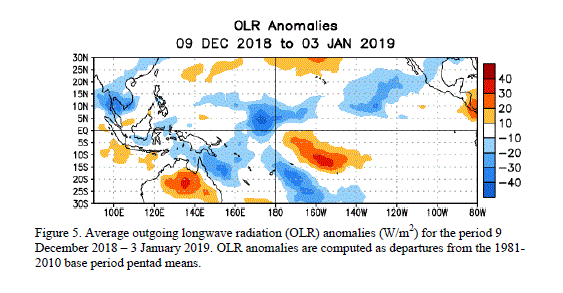#671 Postby cycloneye » Thu May 07, 2009 6:14 am
Australians 7th of May Update of ENSO
SSTs across the central and eastern tropical Pacific continue to warm slowly, as they have done since February. When averaged over the month of April this warming has resulted in the disappearance of cool SST anomalies from the central and eastern equatorial Pacific. SSTs were close to normal everywhere with the exception of the far eastern regions, where they are now warmer than normal. The monthly NINO indices for April were +0.3°C, 0°C and +0.1°C for NINO3, NINO3.4 and NINO4 and respectively.
In terms of weekly data, the most recent NINO indices are +0.6°C, +0.3°C and 0.3°C for NINO3, NINO3.4 and NINO4 respectively. Over the past three weeks all three NINO regions have warmed. NINO3 and NINO3.4 warmed the most with an increase of approximately 0.3°C, while NINO4 warmed by approximately 0.2°C. The 7-day SST anomaly map map shows that SSTs across the central equatorial Pacific are near normal, while warm anomalies are now evident in regions further east. When compared with three weeks ago, positive anomalies in the far east of the Pacific, near South America, have strengthened. An animation of recent SST changes is available.
The sub-surface of the equatorial Pacific continued to warm through April and early May, effectively replacing most of the anomalously cool sub-surface water in the central and eastern tropical Pacific that had persisted since September 2008. A recent map for the 5 days ending 4 May shows warm sub-surface anomalies above +1.0°C evident both in the western and eastern Pacific. An animation of recent sub-surface changes is available.
An archive of past SST and sub-surface temperature charts is available.
Trade winds weakened right across the equatorial Pacific, most notably in late April and early May following a westerly wind burst in the western Pacific. The latest weekly wind anomalies, shown in the TAO/TRITON map (small image above) for the five days ending 4 May, indicate weaker than normal Trades across much of the near-equatorial Pacific.
The Southern Oscillation Index (SOI) rose slowly during much of April, though started to fall once more late in the month and into early May. The SOI rose from a March value of zero to an April value of +9, but the current approximate 30-day value has fallen back to +7 on 5 May. The Tahiti mean sea level pressure (MSLP) anomaly rose once more during April. Prior to March 2009, the Tahiti MSLP had generally been above average since August 2008. The Darwin MSLP fell to slightly below normal by late April. (SOI graph, SOI table).
Cloudiness near the date-line over the central to western Pacific is another important indicator of warm/cool ENSO conditions, as it normally increases/decreases (negative OLR/positive OLR anomalies) during these episodes. Cloudiness near the date-line remained below average in the first half of April, but it has increased to near-normal levels during the past three weeks.
The majority of international dynamic computer models surveyed by the Bureau of Meteorology predict a continuation of neutral conditions for the tropical Pacific until at least mid-winter. Three of the six models are suggesting ENSO neutral conditions for winter and spring, while three models have outlooks for El Niño conditions to develop. However, models are still having to contend with the March to June "predictability barrier". Given this uncertainty and the wide range of predicted outlooks, continuing neutral conditions is the most likely outcome for the period through winter. Models suggest a return to La Niña conditions is the least likely outcome. Recent forecasts from the POAMA model, run daily at the Bureau of Meteorology, show a steady warming, with ENSO-neutral conditions likely to persist through to at least mid-winter, but with the possibility of El Niño conditions into the spring. Pacific conditions and model predictions will continue to be monitored closely for any strengthening indications of an event. POAMA outlooks for the IOD suggest values will reduce slightly, but remain within the neutral range during winter and spring.
0 likes

















